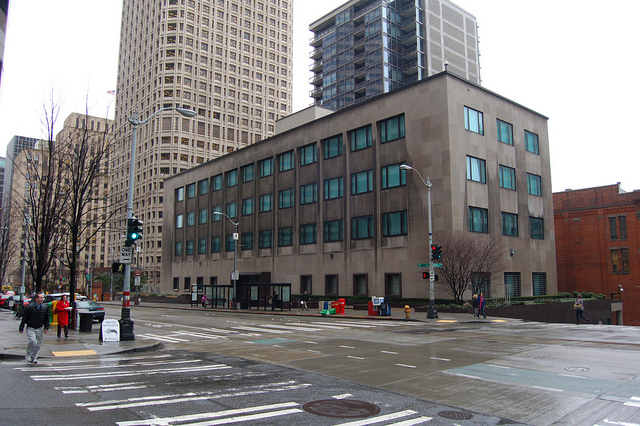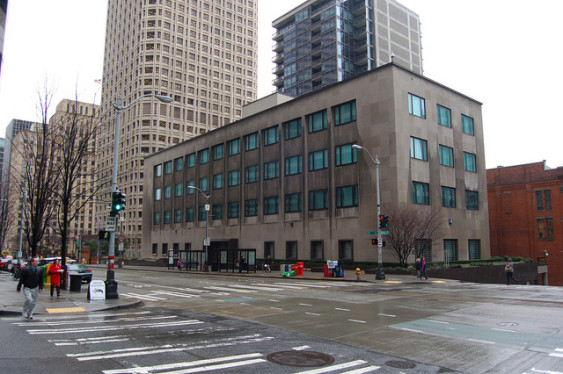Seattle Public Schools officials confirmed this weekend that the district lost its bid to acquire a surplus federal building and turn it into a downtown elementary school. (For more background, see our earlier posts here, here, and here.)
The federal General Services Administration did not immediately disclose who submitted the winning $16 million bid for the former Federal Reserve Bank Building at the corner of Second Avenue and Spring Street, and it’s unclear what plans the new owner has for the building.
Opening a downtown elementary school has been a top priority for downtown advocates and parents, whose children currently have long bus rides to “neighborhood” schools on Capitol Hill or near the Central/International District. Seattle Public Schools had the opportunity to acquire the 90,000-square-foot empty bank building—for free and with little competition—through a federal disposition process that awards surplus buildings to agencies that will put them back into public use within three years.
That three-year timeline spooked school board members, who rejected the option because the district had no renovation funds in its current budget. They decided to try to acquire the building at a public auction, which would have provided additional time and flexibility to line up funding. But it opened the district up to competition from other agencies and private developers, at least one of which had deeper pockets. The district had an upper limit of $5.8 million, officials said Monday, based on the available funds that were included in the last school construction levy for downtown school planning.
The district’s failure to acquire the building through EITHER process suggests that its business-as-usual approach to building new schools isn’t likely to work in a fast-evolving downtown landscape. If the district is serious about addressing the needs of children and families living downtown, it needs to do three things:
- Include serious money in its next capital construction levy proposal for a downtown school, so those funds are available if unexpected opportunities arise. The original deal disintegrated because the district lacked $53 million for estimated renovation costs, and it couldn’t line any up in time to finish a project within three years. To capitalize on any fast-moving downtown estate deal, the district will likely have to be more nimble than that.
- Engage potential partners. When the school district’s stated policies came into conflict with the federal government’s stated policies, school board directors balked. But it remains to be seen whether further discussions with the feds could have resolved some of those differences and given the district the leeway it needed. Under similar circumstances, for instance, the federal government has given other educational institutions additional time to re-purpose buildings.
- Think more creatively and aggressively about how a downtown school might work. This could include renting space in an existing building or pursuing partnerships with downtown developers, the city, or other public institutions that own downtown land. Another downtown building or site of this size isn’t likely to drop in the district’s lap again. If it wants to open a downtown school in the next decade, officials need to start exploring alternative solutions now.











Ted Wolf
School districts are at a deep disadvantage in the competition with private interests for urban properties. Their financing options are limited, and their constraints and needs are pretty unique. It’s too bad this deal went to auction — but not clear that the Seattle school board failed at their due diligence. A rethinking of what a “downtown school” means is definitely in order — maybe it is not the self-contained, brick-and-mortar behemoth we all imagine first! But issues of school security and the complexities of urban parenthood today make those “alternative solutions” pretty darned elusive. Good luck, Seattle! Portland is watching.
Scott Bonjukian
SPS should consider there is another huge public landowner in downtown – the University of Washington. They own ten acres in the heart of the CBD. There’s a huge potential here for two educational providers to collaborate, whether through leasing space in existing buildings or mixed use redevelopment with a new dedicated school with residences on top.